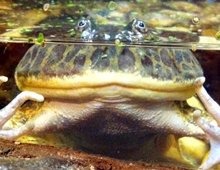Description: Lepidobatrachus frogs are somewhat comical in appearance, appearing to be all mouth. The top of their flattened, round bodies is usually a muddy olive brown to gray in color, with lighter and darker mottling. The cream-colored eyes are set close together, high on the center of their head. On the round snout are two nostrils positioned in front of and between the eyes. With such short legs, they are not good swimmers but the slight webbing on the rear feet does help when swimming. A tubercle is located on each rear foot that is used for shoveling when digging burrows. They do not have teeth, but they do have two sharp-edged structures in the jaws which serve the same purpose.
Size: They can grow to an adult size of four to five inches (10 to 13 cm), with females being larger than males.
Behavior: Budgett’s frogs are highly intelligent and very aggressive. When frightened, they inflate themselves, stand up on their short legs and if this doesn’t deter the potential predator, they lunge at them with an open huge mouth followed up by a shrill shriek. During the dry season, Budgett’s frogs remain in burrows they dig in the bottoms of pools of water. While in the burrow, they will shed several layers of skin from which to form a waterproof cocoon that will keep the frog moist. When the rainy season arrives it will go back into the water to breed and feed.
Diet: It is believed these semi-aquatic frogs are nocturnal and submerge themselves in water or mud, with only their nostrils and eyes showing as they sit and wait for prey. They mainly feed on other frogs (particularly tadpoles), snails and insects.
Senses: They use their exceptional night vision and their sensitivity to movement when hunting food.
Communication: Calls are used for territorial announcement and mating.
Reproduction: After emerging from their underground burrows when the rainy season arrives, they quickly breed in order for the eggs to hatch and the embryos to reach adulthood before the rainy season ends. As many as 1,200 to 1,400 eggs are laid and will hatch into tadpoles within a day or two.
Habitat/range: They are found near or in permanent or seasonal bodies of water in Paraguay, Argentina and Bolivia.
Status: They are listed as Least Concern on the IUCN Red List.



